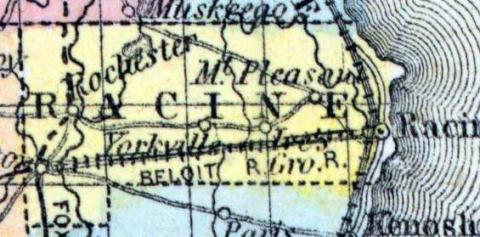RACINE COUNTY, situated on the east boundary of Wisconsin, with Lake Michigan on the east. Area, 610 square miles. Face of the country, undulating; soil, fertile. Seat of justice, Racine. Pop. 1840, 3,475; in 1850, 10,833. (Fanning's, 1853)
RACINE, ras-seen', a county in the S. E. part of Wisconsin, bordering on Luke Michigan, contains about 350 square miles. It is intersected by the Root and Pishtaka rivers. The surface is nearly level, and is mostly occupied by prairies, which are interspersed with oak openings, or plains producing a scattered growth of oak and hickory. The soil is calcareous and fertile. Wheat, Indian corn, oats, and grass are the staples. In 1850 the county produced 218,149 bushels of wheat; 78,847 of corn; 175,665 of oats, and 232,466 pounds of butter. It contained 18 churches, 5 newspaper offices, 3756 pupils attending public schools, and 205 attending academics and other schools. Limestone is the principal rock. The Pishtaka river furnishes motive-power for mills. Racine county was separated from Milwaukee and organized in 1836. The name is derived from Root river, which in French is Racine. It is intersected by the Chicago and Milwaukee railroad. Capital, Racine. Pop., 14,973. (Baldwin's New and Complete Gazetteer of the United States..., 1854)
RACINE, County, is bounded on the north by Waukesha and Milwaukee, on the east by the State line in Lake Michigan, on the south by Kenosha, and on the west by Walworth. It was organized from the limits of Milwaukee Dec. 7, 1836. The seat of justice is at the city of Racine, on the lake shore. This county has a proper proportion of prairie and timber, and is well adapted to agriculture. Its productions are various. Besides other branches of agriculture, the raising of fruit and keeping of cattle and sheep are successfully carried on. There is also a large amount of capital profitably employed in various branches of manufacture. A large portion of the county is well settled and improved. Though small in extent, it possesses advantages unsurpassed by any county in the State. Its soil is well adapted to all the products of the climate, and being contiguous to the lake, it has good and convenient markets both at Racine and other lake ports. Its principal streams are O'Plaine and Root rivers. It is in the first judicial circuit, the first congressional district, and forms the seventh senate district, and sends four members to the assembly, as follows: 1. City of Racine; 2. Towns of Racine, Mount Pleasant and Caledonia; 3. Towns of Yorkville, Dover, Raymond and Norway; 4. Towns of Burlington and Rochester. The population in 1838 was 2,054; 1840,3,475; 1842 6,318; 1846, 17,983; 1847, 19,583; 1850, 14,971. It has 947 farms, 2,578 dwellings, and 99 manufactories. (John Warren Hunt, Wisconsin Gazetteer..., Madison, 1853)

